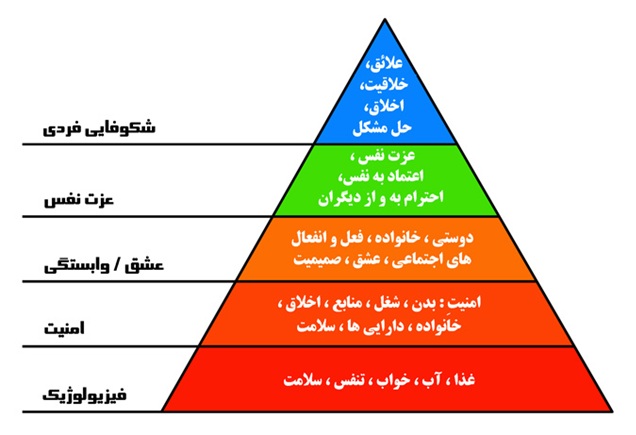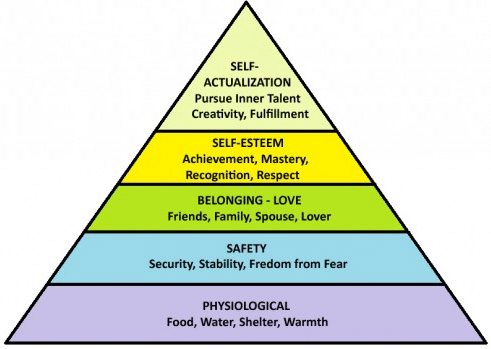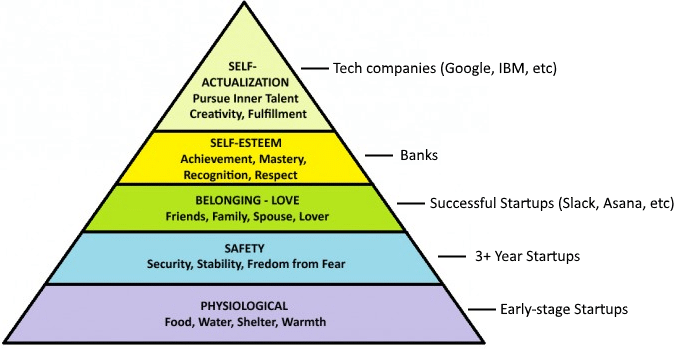هرم نیازمندیهای مازلو بعنوان چارچوبی برای کسب وکارها

There are a lot of business frameworks in the world. Some are great, many are just ok. Depending on what you’re trying to achieve, there’s probably a business framework out there that will suit
you pretty well. But there’s one framework that keeps popping up everywhere I look. And the crazy thing is – it wasn’t even designed as a business framework at all…
I studied business at university. I don’t remember many of the lectures – but I do remember making a snide comment when a professor of psychology stood-in for one of our regular lecturers. As it turned out, the most memorable lecture of my 4 years of study was the one that wasn’t even meant to have happened.
The lecture was about Maslow’s Hierarchy of Needs.
You’ve probably heard of it before – it’s incredibly famous. It describes how human beings work through accomplishing their needs – starting with the needs of basic survival, and culminating in something Maslow called ‘self actualization’. Here’s a quick look at Maslow’s Hierarchy of Needs in full:

I’ve always LOVED this framework. It’s beautifully simple, incredibly versatile and I can relate to it on a personal level in so many different ways. It describes what we often see as ‘the model lifetime’ – humble beginnings followed by a series of ever-more-challenging accomplishments that ultimately take us to a place in our lives beyond money, beyond even friendship – to self actualization. Or as Maslow describes it “to achieving one’s full potential”.
A few weeks ago, I was sitting with my friend and cofounder Eric, and we were talking about the journey that our startup has been on. We reminisced about the early days of paying wages from our personal bank accounts and coming into the office on weekends to vacuum the floors. For some reason, we started comparing the journey to Maslow’s Hierarchy and I was surprised to discover that it was one of Eric’s favorite frameworks too.
We realized that the journey of a business is almost exactly the same as the journey of a human being through life.
You start in survival mode – scrapping for every bit of cash, every sale you can possibly grab.
Then, if you do survive, you move into safety mode – stockpiling enough capital to live through any storms that may come.
Next up is belonging. You start having an impact on your staff and your customers.
Then (if you’re lucky) comes success – achievement and accomplishment. Maybe in the form of profit, or maybe in the form of recognition from your industry or competitors.
Last up, if your business has made it this far – you finally start to think bigger. You think about how you could change the world – or at least make it better. The business equivalent of self-actualization – fulfilling your true potential.
For fun, we decided to plot some well-known industries onto Maslow’s Hierarchy of Needs to see what that might look like:

This is of course a highly subjective assessment. But here’s our thinking:
| Self Actualization | Tech companies like Google are changing lives on a scale that reaches far beyond their direct customer base. Whether it’s artificial intelligence, self-driving cars or the humble search engine. Much of what they do isn’t about directly making money, but exploring new ideas and experimentation. |
| Self-Esteem | Banks are hugely successful at what they do. But for the most part, don’t push their limits very much when it comes to trying new things. Most of what they do is about making direct revenue. |
| Belonging – Love | Successful startups like Slack and Asana are rapidly becoming household names. They’re financially successful and are wining praise from both inside and outside of the tech world. |
| Safety | 3+ Year startups are established and profitable having survived the painful early years. But they still have half an eye on survival, even as they explore opportunities for growth. |
| Physiological | Early stage startups are fighting for every scrap of capital they can find. Be it from investors, grants or sales – nothing else matters if they can’t survive. |
My single favorite thing about Maslow’s Hierarchy of Needs is that it redefines what ‘success’ means for an organization. Typically, the pinnacle of success in business would be profit. Profit obtained ethically and fairly – but profit nonetheless. Whereas with this framework guiding you, the pinnacle of success goes beyond profit alone. Self actualization for a business could be about making money. But I’d rather think of it as meaning that the business has gotten to a point where it’s having a positive impact on society, beyond its own successes.
How can I apply Maslow’s Hierarchy of Needs as a business framework?
When you think about strategy – the main objective it to take your business from somewhere, to somewhere else. Strategy is all about taking you up the pyramid. But to start the journey, you need to understand where you are today.
So…where does your organization sit on the pyramid?
Be brutally honest about your success so far. The majority of organizations will exist in the bottom 2-3 segments of the pyramid.
When you create your strategic plan, one of the most important things is to be realistic. Overly ambitious plans lose traction fast. So once you know where you are in the pyramid, create your plan so that it moves you one level up. Any less than one level, and you’re probably being too conservative. Any more, and you’re probably not being realistic about what you can achieve.
Using Maslow’s Hierarchy of Needs to make you a better leader
Another great thing about this particular business framework, is that you can even apply it to the way in which you lead your people. The experiences that you provide as an employer can actually help people climb up the hierarchy of needs in their personal lives.
I’ll assume that you’re already paying your people well enough to cover level one: physiological needs.
I’ll also assume that you’re ensuring a safe and supportive working environment.
Great places to work go much further than that though. They provide opportunities for people to explore new skills. To achieve mastery of their chosen craft and to explore things about themselves that they didn’t even know they had in them.
The next time you have a 1:1 discussion with one of your team, think about where they currently sit on the pyramid and work out a plan with them to get them up to the next stage.
Hopefully you can see why I love this framework so much. Now I’d like to hear – what’s your favorite business framework? And why? Let us know in the comments, or via social media!


